transmission SATURN AURA HYBRID 2008 Owners Manual
[x] Cancel search | Manufacturer: SATURN, Model Year: 2008, Model line: AURA HYBRID, Model: SATURN AURA HYBRID 2008Pages: 362, PDF Size: 2.05 MB
Page 77 of 362
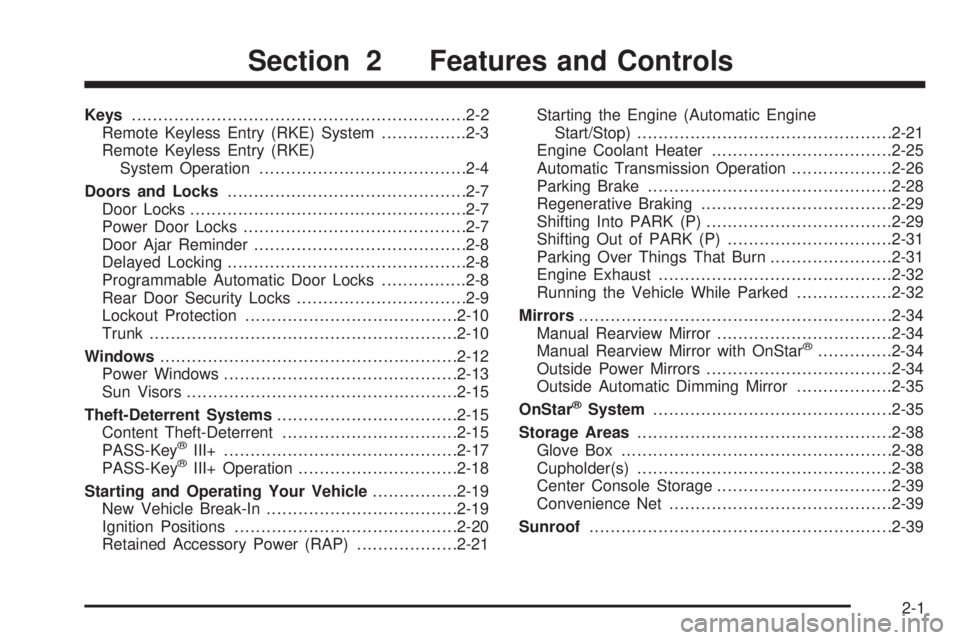
Keys...............................................................2-2
Remote Keyless Entry (RKE) System................2-3
Remote Keyless Entry (RKE)
System Operation.......................................2-4
Doors and Locks.............................................2-7
Door Locks....................................................2-7
Power Door Locks..........................................2-7
Door Ajar Reminder........................................2-8
Delayed Locking.............................................2-8
Programmable Automatic Door Locks................2-8
Rear Door Security Locks................................2-9
Lockout Protection........................................2-10
Trunk..........................................................2-10
Windows........................................................2-12
Power Windows............................................2-13
Sun Visors...................................................2-15
Theft-Deterrent Systems..................................2-15
Content Theft-Deterrent.................................2-15
PASS-Key
®III+............................................2-17
PASS-Key®III+ Operation..............................2-18
Starting and Operating Your Vehicle................2-19
New Vehicle Break-In....................................2-19
Ignition Positions..........................................2-20
Retained Accessory Power (RAP)...................2-21Starting the Engine (Automatic Engine
Start/Stop)................................................2-21
Engine Coolant Heater..................................2-25
Automatic Transmission Operation...................2-26
Parking Brake..............................................2-28
Regenerative Braking....................................2-29
Shifting Into PARK (P)...................................2-29
Shifting Out of PARK (P)...............................2-31
Parking Over Things That Burn.......................2-31
Engine Exhaust............................................2-32
Running the Vehicle While Parked..................2-32
Mirrors...........................................................2-34
Manual Rearview Mirror.................................2-34
Manual Rearview Mirror with OnStar
®..............2-34
Outside Power Mirrors...................................2-34
Outside Automatic Dimming Mirror..................2-35
OnStar
®System.............................................2-35
Storage Areas................................................2-38
Glove Box...................................................2-38
Cupholder(s)................................................2-38
Center Console Storage.................................2-39
Convenience Net..........................................2-39
Sunroof.........................................................2-39
Section 2 Features and Controls
2-1
Page 96 of 362
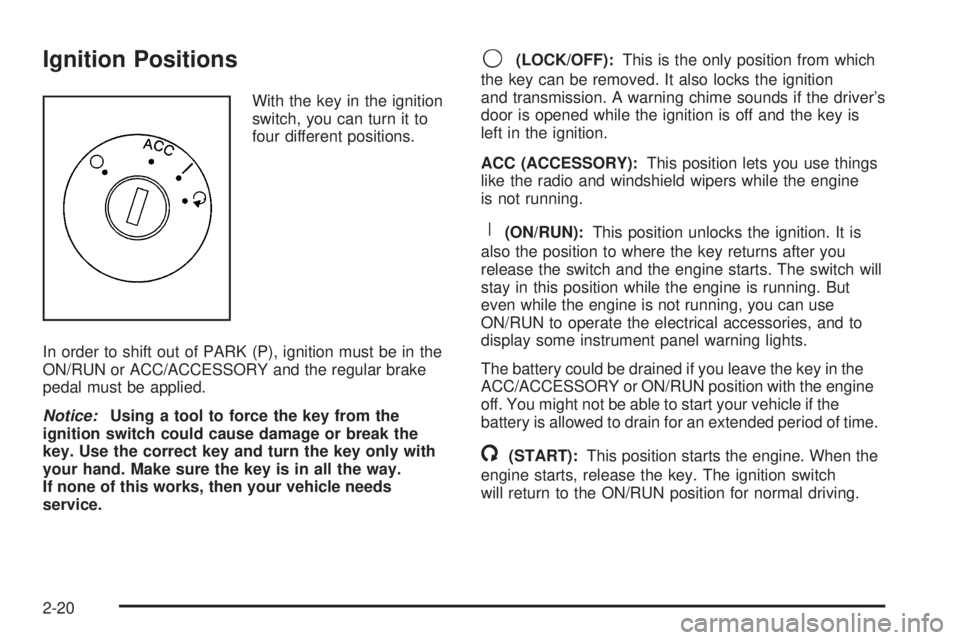
Ignition Positions
With the key in the ignition
switch, you can turn it to
four different positions.
In order to shift out of PARK (P), ignition must be in the
ON/RUN or ACC/ACCESSORY and the regular brake
pedal must be applied.
Notice:Using a tool to force the key from the
ignition switch could cause damage or break the
key. Use the correct key and turn the key only with
your hand. Make sure the key is in all the way.
If none of this works, then your vehicle needs
service.
9(LOCK/OFF):This is the only position from which
the key can be removed. It also locks the ignition
and transmission. A warning chime sounds if the driver’s
door is opened while the ignition is off and the key is
left in the ignition.
ACC (ACCESSORY):This position lets you use things
like the radio and windshield wipers while the engine
is not running.
R(ON/RUN):This position unlocks the ignition. It is
also the position to where the key returns after you
release the switch and the engine starts. The switch will
stay in this position while the engine is running. But
even while the engine is not running, you can use
ON/RUN to operate the electrical accessories, and to
display some instrument panel warning lights.
The battery could be drained if you leave the key in the
ACC/ACCESSORY or ON/RUN position with the engine
off. You might not be able to start your vehicle if the
battery is allowed to drain for an extended period of time.
/(START):This position starts the engine. When the
engine starts, release the key. The ignition switch
will return to the ON/RUN position for normal driving.
2-20
Page 97 of 362
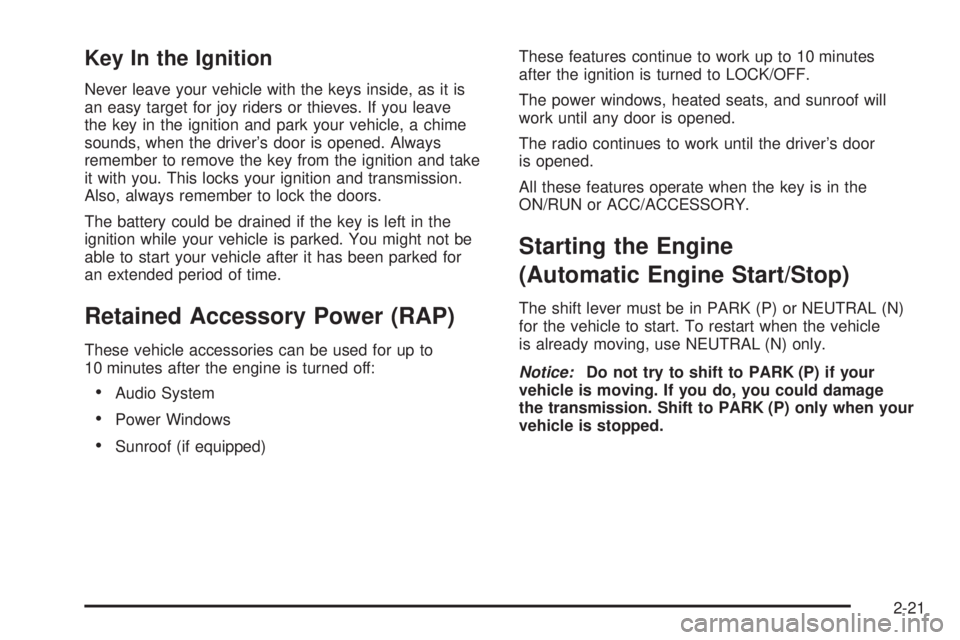
Key In the Ignition
Never leave your vehicle with the keys inside, as it is
an easy target for joy riders or thieves. If you leave
the key in the ignition and park your vehicle, a chime
sounds, when the driver’s door is opened. Always
remember to remove the key from the ignition and take
it with you. This locks your ignition and transmission.
Also, always remember to lock the doors.
The battery could be drained if the key is left in the
ignition while your vehicle is parked. You might not be
able to start your vehicle after it has been parked for
an extended period of time.
Retained Accessory Power (RAP)
These vehicle accessories can be used for up to
10 minutes after the engine is turned off:
Audio System
Power Windows
Sunroof (if equipped)These features continue to work up to 10 minutes
after the ignition is turned to LOCK/OFF.
The power windows, heated seats, and sunroof will
work until any door is opened.
The radio continues to work until the driver’s door
is opened.
All these features operate when the key is in the
ON/RUN or ACC/ACCESSORY.
Starting the Engine
(Automatic Engine Start/Stop)
The shift lever must be in PARK (P) or NEUTRAL (N)
for the vehicle to start. To restart when the vehicle
is already moving, use NEUTRAL (N) only.
Notice:Do not try to shift to PARK (P) if your
vehicle is moving. If you do, you could damage
the transmission. Shift to PARK (P) only when your
vehicle is stopped.
2-21
Page 98 of 362
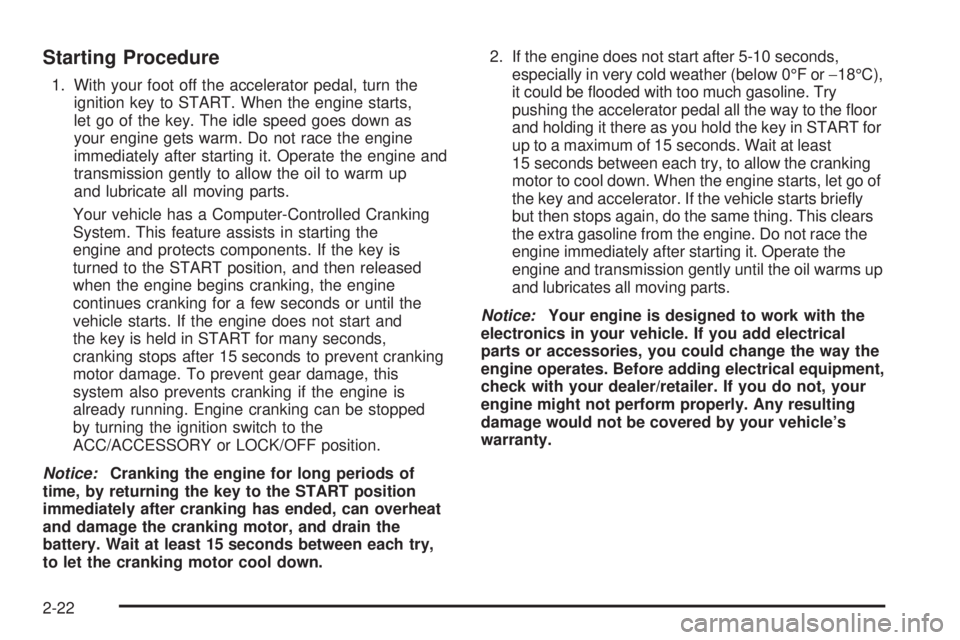
Starting Procedure
1. With your foot off the accelerator pedal, turn the
ignition key to START. When the engine starts,
let go of the key. The idle speed goes down as
your engine gets warm. Do not race the engine
immediately after starting it. Operate the engine and
transmission gently to allow the oil to warm up
and lubricate all moving parts.
Your vehicle has a Computer-Controlled Cranking
System. This feature assists in starting the
engine and protects components. If the key is
turned to the START position, and then released
when the engine begins cranking, the engine
continues cranking for a few seconds or until the
vehicle starts. If the engine does not start and
the key is held in START for many seconds,
cranking stops after 15 seconds to prevent cranking
motor damage. To prevent gear damage, this
system also prevents cranking if the engine is
already running. Engine cranking can be stopped
by turning the ignition switch to the
ACC/ACCESSORY or LOCK/OFF position.
Notice:Cranking the engine for long periods of
time, by returning the key to the START position
immediately after cranking has ended, can overheat
and damage the cranking motor, and drain the
battery. Wait at least 15 seconds between each try,
to let the cranking motor cool down.2. If the engine does not start after 5-10 seconds,
especially in very cold weather (below 0°F or−18°C),
it could be �ooded with too much gasoline. Try
pushing the accelerator pedal all the way to the �oor
and holding it there as you hold the key in START for
up to a maximum of 15 seconds. Wait at least
15 seconds between each try, to allow the cranking
motor to cool down. When the engine starts, let go of
the key and accelerator. If the vehicle starts brie�y
but then stops again, do the same thing. This clears
the extra gasoline from the engine. Do not race the
engine immediately after starting it. Operate the
engine and transmission gently until the oil warms up
and lubricates all moving parts.
Notice:Your engine is designed to work with the
electronics in your vehicle. If you add electrical
parts or accessories, you could change the way the
engine operates. Before adding electrical equipment,
check with your dealer/retailer. If you do not, your
engine might not perform properly. Any resulting
damage would not be covered by your vehicle’s
warranty.
2-22
Page 100 of 362
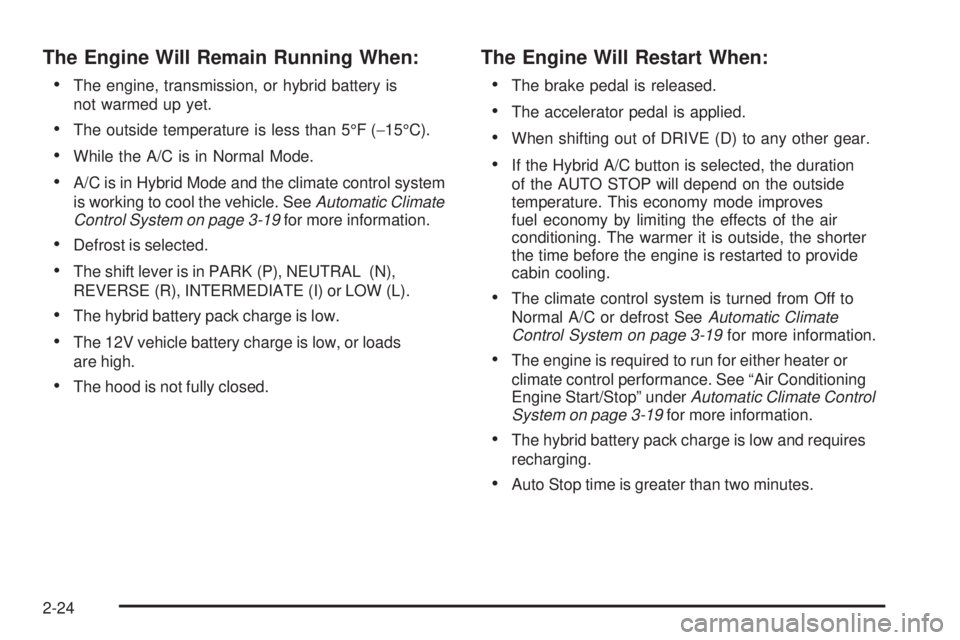
The Engine Will Remain Running When:
The engine, transmission, or hybrid battery is
not warmed up yet.
The outside temperature is less than 5°F (−15°C).
While the A/C is in Normal Mode.
A/C is in Hybrid Mode and the climate control system
is working to cool the vehicle. SeeAutomatic Climate
Control System on page 3-19for more information.
Defrost is selected.
The shift lever is in PARK (P), NEUTRAL (N),
REVERSE (R), INTERMEDIATE (I) or LOW (L).
The hybrid battery pack charge is low.
The 12V vehicle battery charge is low, or loads
are high.
The hood is not fully closed.
The Engine Will Restart When:
The brake pedal is released.
The accelerator pedal is applied.
When shifting out of DRIVE (D) to any other gear.
If the Hybrid A/C button is selected, the duration
of the AUTO STOP will depend on the outside
temperature. This economy mode improves
fuel economy by limiting the effects of the air
conditioning. The warmer it is outside, the shorter
the time before the engine is restarted to provide
cabin cooling.
The climate control system is turned from Off to
Normal A/C or defrost SeeAutomatic Climate
Control System on page 3-19for more information.
The engine is required to run for either heater or
climate control performance. See “Air Conditioning
Engine Start/Stop” underAutomatic Climate Control
System on page 3-19for more information.
The hybrid battery pack charge is low and requires
recharging.
Auto Stop time is greater than two minutes.
2-24
Page 102 of 362
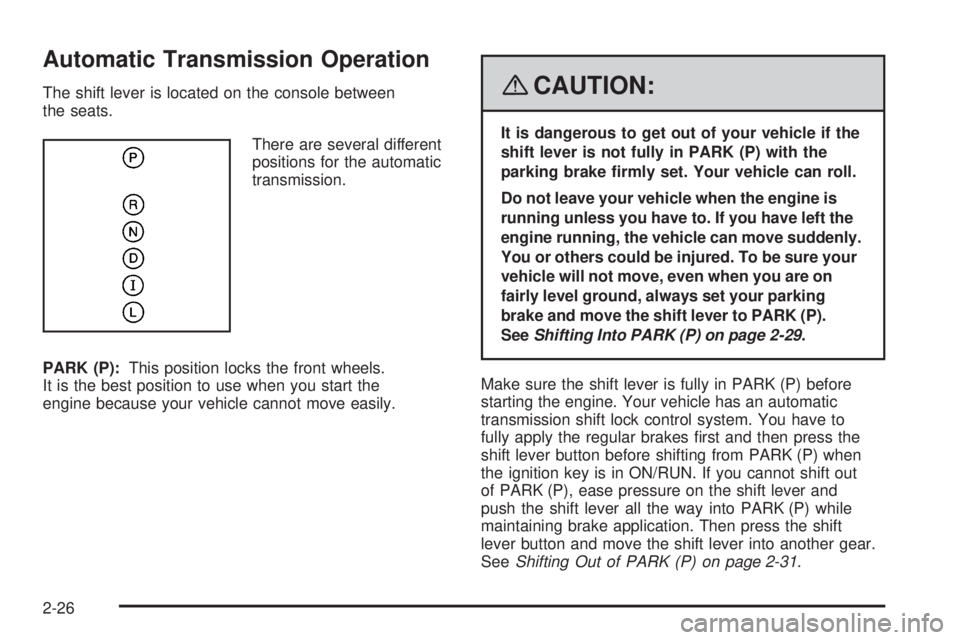
Automatic Transmission Operation
The shift lever is located on the console between
the seats.
There are several different
positions for the automatic
transmission.
PARK (P):This position locks the front wheels.
It is the best position to use when you start the
engine because your vehicle cannot move easily.{CAUTION:
It is dangerous to get out of your vehicle if the
shift lever is not fully in PARK (P) with the
parking brake �rmly set. Your vehicle can roll.
Do not leave your vehicle when the engine is
running unless you have to. If you have left the
engine running, the vehicle can move suddenly.
You or others could be injured. To be sure your
vehicle will not move, even when you are on
fairly level ground, always set your parking
brake and move the shift lever to PARK (P).
SeeShifting Into PARK (P) on page 2-29.
Make sure the shift lever is fully in PARK (P) before
starting the engine. Your vehicle has an automatic
transmission shift lock control system. You have to
fully apply the regular brakes �rst and then press the
shift lever button before shifting from PARK (P) when
the ignition key is in ON/RUN. If you cannot shift out
of PARK (P), ease pressure on the shift lever and
push the shift lever all the way into PARK (P) while
maintaining brake application. Then press the shift
lever button and move the shift lever into another gear.
SeeShifting Out of PARK (P) on page 2-31.
2-26
Page 103 of 362
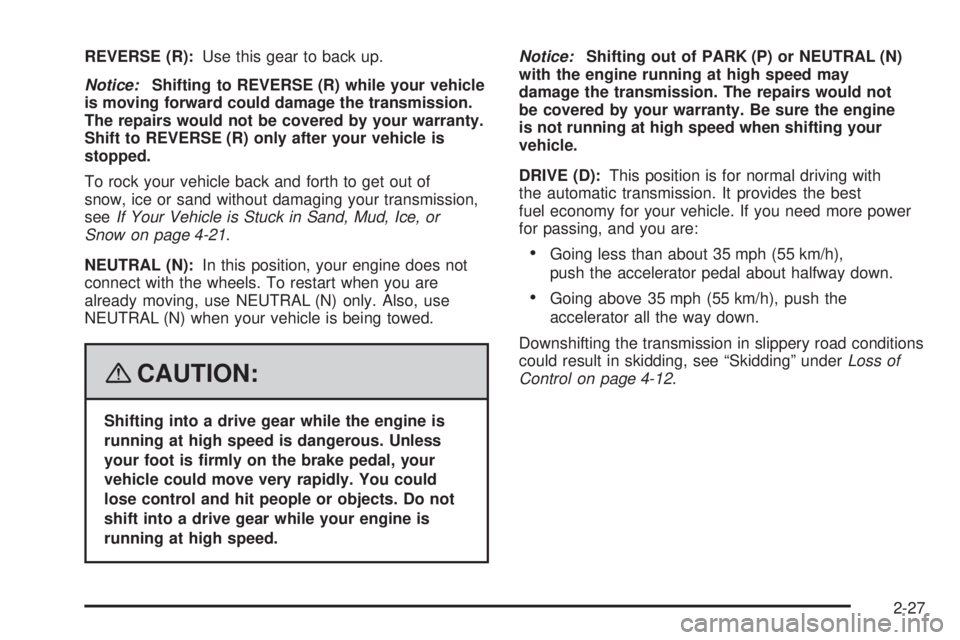
REVERSE (R):Use this gear to back up.
Notice:Shifting to REVERSE (R) while your vehicle
is moving forward could damage the transmission.
The repairs would not be covered by your warranty.
Shift to REVERSE (R) only after your vehicle is
stopped.
To rock your vehicle back and forth to get out of
snow, ice or sand without damaging your transmission,
seeIf Your Vehicle is Stuck in Sand, Mud, Ice, or
Snow on page 4-21.
NEUTRAL (N):In this position, your engine does not
connect with the wheels. To restart when you are
already moving, use NEUTRAL (N) only. Also, use
NEUTRAL (N) when your vehicle is being towed.
{CAUTION:
Shifting into a drive gear while the engine is
running at high speed is dangerous. Unless
your foot is �rmly on the brake pedal, your
vehicle could move very rapidly. You could
lose control and hit people or objects. Do not
shift into a drive gear while your engine is
running at high speed.Notice:Shifting out of PARK (P) or NEUTRAL (N)
with the engine running at high speed may
damage the transmission. The repairs would not
be covered by your warranty. Be sure the engine
is not running at high speed when shifting your
vehicle.
DRIVE (D):This position is for normal driving with
the automatic transmission. It provides the best
fuel economy for your vehicle. If you need more power
for passing, and you are:
Going less than about 35 mph (55 km/h),
push the accelerator pedal about halfway down.
Going above 35 mph (55 km/h), push the
accelerator all the way down.
Downshifting the transmission in slippery road conditions
could result in skidding, see “Skidding” underLoss of
Control on page 4-12.
2-27
Page 104 of 362
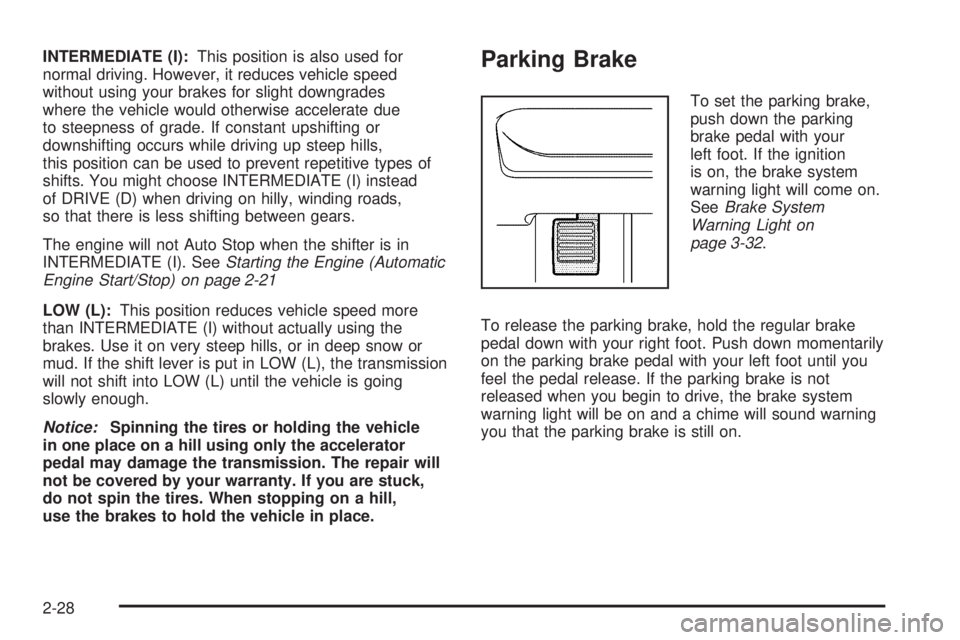
INTERMEDIATE (I):This position is also used for
normal driving. However, it reduces vehicle speed
without using your brakes for slight downgrades
where the vehicle would otherwise accelerate due
to steepness of grade. If constant upshifting or
downshifting occurs while driving up steep hills,
this position can be used to prevent repetitive types of
shifts. You might choose INTERMEDIATE (I) instead
of DRIVE (D) when driving on hilly, winding roads,
so that there is less shifting between gears.
The engine will not Auto Stop when the shifter is in
INTERMEDIATE (I). SeeStarting the Engine (Automatic
Engine Start/Stop) on page 2-21
LOW (L):This position reduces vehicle speed more
than INTERMEDIATE (I) without actually using the
brakes. Use it on very steep hills, or in deep snow or
mud. If the shift lever is put in LOW (L), the transmission
will not shift into LOW (L) until the vehicle is going
slowly enough.
Notice:Spinning the tires or holding the vehicle
in one place on a hill using only the accelerator
pedal may damage the transmission. The repair will
not be covered by your warranty. If you are stuck,
do not spin the tires. When stopping on a hill,
use the brakes to hold the vehicle in place.Parking Brake
To set the parking brake,
push down the parking
brake pedal with your
left foot. If the ignition
is on, the brake system
warning light will come on.
SeeBrake System
Warning Light on
page 3-32.
To release the parking brake, hold the regular brake
pedal down with your right foot. Push down momentarily
on the parking brake pedal with your left foot until you
feel the pedal release. If the parking brake is not
released when you begin to drive, the brake system
warning light will be on and a chime will sound warning
you that the parking brake is still on.
2-28
Page 106 of 362
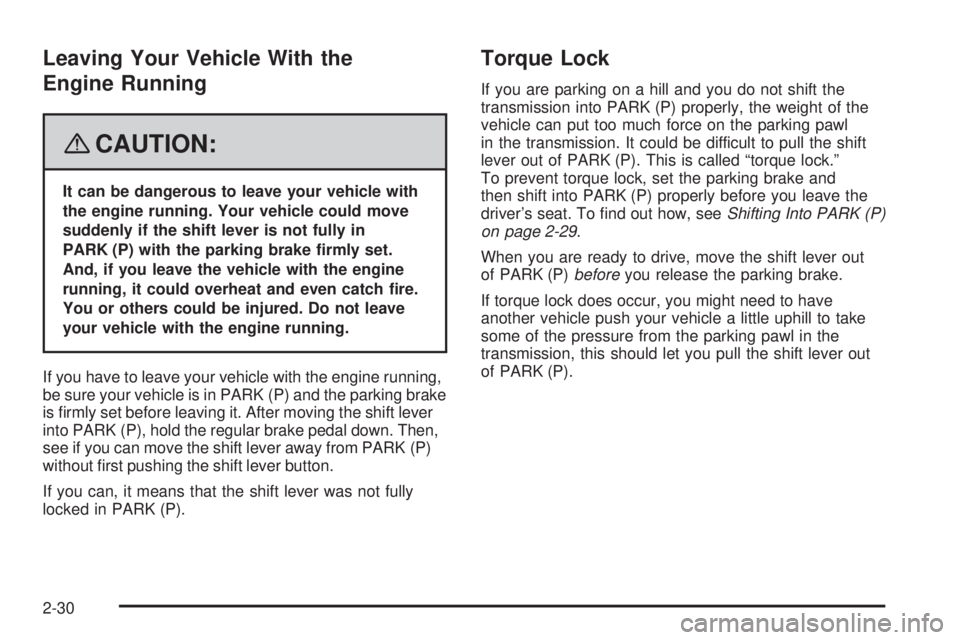
Leaving Your Vehicle With the
Engine Running
{CAUTION:
It can be dangerous to leave your vehicle with
the engine running. Your vehicle could move
suddenly if the shift lever is not fully in
PARK (P) with the parking brake �rmly set.
And, if you leave the vehicle with the engine
running, it could overheat and even catch �re.
You or others could be injured. Do not leave
your vehicle with the engine running.
If you have to leave your vehicle with the engine running,
be sure your vehicle is in PARK (P) and the parking brake
is �rmly set before leaving it. After moving the shift lever
into PARK (P), hold the regular brake pedal down. Then,
see if you can move the shift lever away from PARK (P)
without �rst pushing the shift lever button.
If you can, it means that the shift lever was not fully
locked in PARK (P).
Torque Lock
If you are parking on a hill and you do not shift the
transmission into PARK (P) properly, the weight of the
vehicle can put too much force on the parking pawl
in the transmission. It could be difficult to pull the shift
lever out of PARK (P). This is called “torque lock.”
To prevent torque lock, set the parking brake and
then shift into PARK (P) properly before you leave the
driver’s seat. To �nd out how, seeShifting Into PARK (P)
on page 2-29.
When you are ready to drive, move the shift lever out
of PARK (P)beforeyou release the parking brake.
If torque lock does occur, you might need to have
another vehicle push your vehicle a little uphill to take
some of the pressure from the parking pawl in the
transmission, this should let you pull the shift lever out
of PARK (P).
2-30
Page 121 of 362
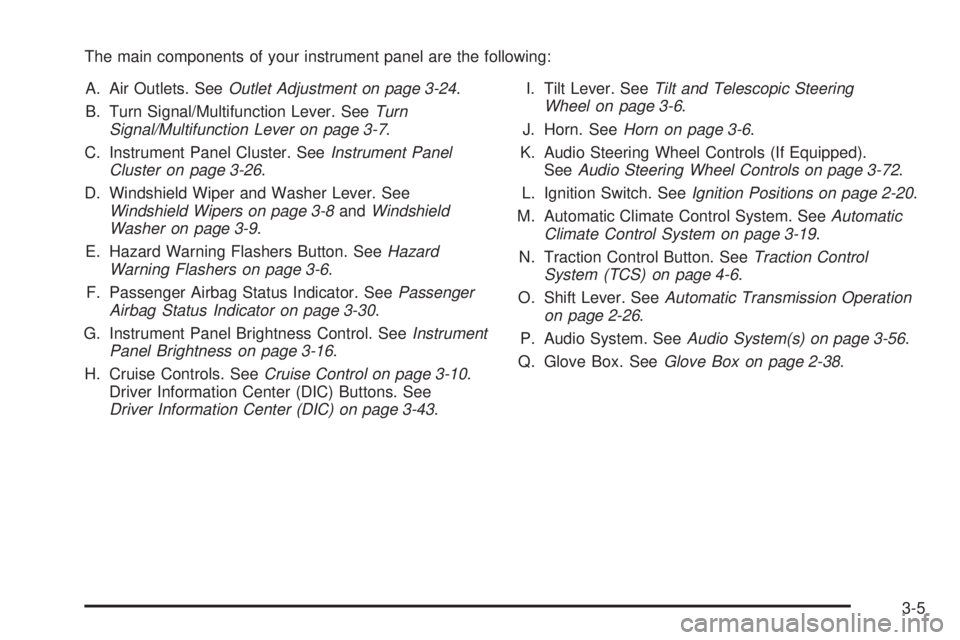
The main components of your instrument panel are the following:
A. Air Outlets. SeeOutlet Adjustment on page 3-24.
B. Turn Signal/Multifunction Lever. SeeTurn
Signal/Multifunction Lever on page 3-7.
C. Instrument Panel Cluster. SeeInstrument Panel
Cluster on page 3-26.
D. Windshield Wiper and Washer Lever. See
Windshield Wipers on page 3-8andWindshield
Washer on page 3-9.
E. Hazard Warning Flashers Button. SeeHazard
Warning Flashers on page 3-6.
F. Passenger Airbag Status Indicator. SeePassenger
Airbag Status Indicator on page 3-30.
G. Instrument Panel Brightness Control. SeeInstrument
Panel Brightness on page 3-16.
H. Cruise Controls. SeeCruise Control on page 3-10.
Driver Information Center (DIC) Buttons. See
Driver Information Center (DIC) on page 3-43.I. Tilt Lever. SeeTilt and Telescopic Steering
Wheel on page 3-6.
J. Horn. SeeHorn on page 3-6.
K. Audio Steering Wheel Controls (If Equipped).
SeeAudio Steering Wheel Controls on page 3-72.
L. Ignition Switch. SeeIgnition Positions on page 2-20.
M. Automatic Climate Control System. SeeAutomatic
Climate Control System on page 3-19.
N. Traction Control Button. SeeTraction Control
System (TCS) on page 4-6.
O. Shift Lever. SeeAutomatic Transmission Operation
on page 2-26.
P. Audio System. SeeAudio System(s) on page 3-56.
Q. Glove Box. SeeGlove Box on page 2-38.
3-5